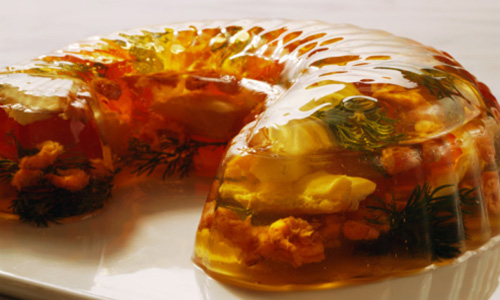
Ingredients for 4 servings:
- 10 white gelatine sheets
- 1 carrot
- 600 g white fish fillet (e.g. monkfish, ling or cod fillet)
- 1 jar (400 ml) fish stock
- 1 egg white (M)
- 1/2 jar (200 ml) lobster stock
- 125 ml dry white wine
- 100 g North Sea shrimp
- 100 g crabmeat (available in the refrigerated section of your supermarket)
- 1-2 tbsp aniseed schnapps
- Salt and pepper
- A few splashes of lemon juice
- A few sprigs of dill
Preparation:
- Soak gelatine in plenty of cold water.
- Peel, clean and cut carrot into thin slices. Cook in salt water for approx. 8 minutes. Then strain, rinse with cold water and drain well.
- Rinse fish fillet and slice into bite-sized pieces. Bring fish stock to a boil and add fish pieces. Simmer for approx. 4-5 minutes on a low heat until tender. Remove fish pieces from stock using a skimmer.
- To clarify the fish stock, bring fish stock to a boil and mix in egg white, again bringing the stock to a boil. Skim off froth. Add lobster stock and white wine to the fish stock, bring to a boil once and season with salt, pepper, aniseed schnapps and lemon juice. Drain gelatine and dissolve in the hot fish stock.
- Rinse a 1.5-2 litre fish mould with cold water. Add layers of fish, sliced carrot, shrimp and crabmeat as well as dill sprigs. Pour fish stock into the mould. Refrigerate for 3-4 hours until the liquid has set.
Serve with fried potatoes.
Tip: Should you not have a suitable mould, you can also use an approx. 24 cm Savarin or rice ring mould.
Click here for more information on cooking and baking with gelatine.
Nutritional values per person approx.:
- Calories: 192
- Joules: 803
- Protein: 33.1 g
- Fat: 5.6 g
- Carbohydrates: 2 g
A well-loved kitchen classic - and that as early as the 19th century
Summer is on its way, and everyone wants something cold for those hot days. Aspic dishes are positively ideal for light and refreshing summer cuisine. Whether prepared with a bit of spice as a meat or fish entrée or as a vegetable dish, whether served classy or made on a low budget, these jellied delicacies captivate through their wide spectrum of flavour. Moreover, aspic dishes are decorative, simple to make and will keep quite well. Aspic dishes are all-rounders in the kitchen and always good for a very special taste experience.
Sweet jellies and spicy aspic dishes were already an established part of aristocratic cuisine as early as the 19th century. To ensure that what was sure to tantalize the taste buds would be a feast for the eyes as well, puddings and cakes were served in a - today unimaginable - diversity of shapes and sizes.
Things became even more extravagant with the luxury dining of the late 19th century. Contemporary courtly and upper middle-class culinary practices dictated the use of different moulds for such dishes as "Sweet Aspic from Danziger Goldwasser" or "Partridges in Aspic". The sugary or salty elements - meat, vegetables, fruit - appeared to be virtually floating through the clear mixture.
A few tips to keep in mind
- Fancy savoury aspics should be prepared with defatted broths since very fatty broths make a cloudy aspic.
- Practical for their preparation are stainless steel square baking tins or tureens, because aspics are easiest to remove from these types of moulds. If you briefly dip the mould into hot water, it will warm up the mould, melting the aspic along the edges. This makes it possible to demould the aspic effortlessly. When using other types of materials it is advisable to line the mould with plastic wrap, which makes it easier to lift the aspic out of the mould later.
- When the aspic is to be prepared in a square baking tin so that it can later be cut into slices and served, the blade of the (sharp) knife should be dipped into hot water. This ensures that the aspic can be cut through without any difficulty and keeps it from sticking to the knife.
Lots of success in giving it a try!